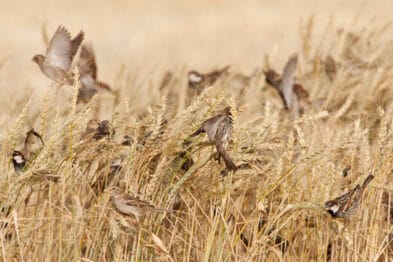Eyal G. Frank, Qinyun Wang, Shaoda Wang, Xuebin Wang, Yang You
Context
Degradation of ecosystems can negatively affect human wellbeing, with agriculture especially vulnerable because of its strong connection to its surrounding ecosystem. This study looks at the impact of the local extinction of the sparrow in China, and its role in inciting China’s Great Famine—the world’s most deadly famine, which led to tens of millions of people dying of starvation between 1959 and 1961.
In 1958, China included the sparrow in its “Four Pests Campaign,” which aimed to improve agricultural activity and human health by eradicating flies, mosquitoes, rats and sparrows. While the other pests were targeted because of public health concerns, sparrows made the list because it was thought they were eating grain crops. However, while adult sparrows do eat grains, they also feed their fledglings insects, making them a predator to crop-damaging pests. The government ignored scientific advice and successfully drove sparrows to local extinction within two years.
There is anecdotal evidence that China experienced large crop pest outbreaks following the collapse of the sparrow population, with environmental historians long arguing that the sparrows’ collapse played a role in forming the conditions that gave rise to the Great Chinese Famine. This study provides quantitative evidence.
Research Design
The study uses newly-digitized data on historical agriculture production for rice, wheat and sweet potato crops, as well as demographic mortality and population data. Because data on the sparrow population did not exist during the study period, the researchers use a proxy for sparrow population levels in the form of a habitat suitability score for each county and province. This score combines data on current observations of sparrows with the environmental features in each county to quantify the degree to which a habitat is suitable for sparrows. The researchers compare how counties that were more suitable for sparrows differed from counties that were less suitable before and after the Four Pests Campaign began in 1958.
Findings
Rice and wheat crops declined in counties more impacted by the killing of sparrows.
Rice and wheat crops are grown above ground, making them more vulnerable to pests. While counties more suitable for sparrows had similar rice and wheat production compared to counties less suitable for sparrows before the Four Pests Campaign, that changed after the sparrows began being eradicated. The counties thought to have a higher sparrow population initially saw a 5.3 percent decline in rice yields and an 8.7 percent decline in wheat yields after the sparrows were killed, likely due to an increase in pests such as locusts in those counties.
Farmers grew more crops and substituted vulnerable above-ground crops for below-ground sweet potato crops in more effected counties.
To make up for failing crops, farmers could have substituted the failing crops for crops less vulnerable to pests, and they could have grown more crops. The study found the farmers in counties thought to have been most impacted by the loss of the sparrows did both.
While above-ground crops declined during the Four Pests Campaign, crops grown below ground—such as sweet potatoes—flourished in counties thought to have had high sparrow populations because they were less vulnerable to the pests that were likely on the rise in these areas. This indicates that farmers substituted their rice and wheat crops for sweet potato crops to mitigate the risk of their food being eaten by pests. Additionally, farmers didn’t just substitute above-ground crops for below-ground crops, they also expanded the amount of land they cultivated in the more effected counties. Both results are consistent with historical context. In 1960, the Chinese government permitted farmers to cultivate more land and grow sweet potatoes for their own consumption to cope with the famine.
The government further exacerbated the impact of the famine in areas thought to have had large sparrow populations by requiring farmers in these counties to sell more of their crops.
In counties thought to have previously had high sparrow populations—counties already suffering the worst crop losses—the government required farmers to sell more of their crops, leading these communities to have less food for themselves and worsening the famine. The government redistributed food in this way because it believed, contrary to widespread scientific advice at the time, that sparrow eradication had boosted agricultural output in these counties, when the opposite was true. As China’s Vice Premier Tan Zhenlin said in 1960, “the achievement of the FPC is more than clear; sparrows have mostly been eradicated, crop yield has been growing steadily, we have already greatly alleviated the negative impacts of sparrows on agricultural production.”
Death rates increased and birth rates decreased in the counties most impacted by the sparrow killings. The impacts peaked in 1960, the worst year of the Great Famine.
Because counties most impacted by the sparrow collapse experienced both a decline in agricultural production, and, at the same time, were required to sell more of their crop yields, they likely experienced a higher degree of food shortages. The data supports this. While mortality and fertility trends were similar in high-sparrow and low-sparrow counties prior to the killing off of the sparrows, the trends began to divert in 1958. Mortality spiked in the high-sparrow counties in 1960—the peak of the famine—and birth rates likewise dropped.
The eradication of the sparrow was responsible for nearly 2 million lives lost during the Great Famine.
Using back-of-the-envelope calculations, the study found that the sparrow killing can account for 19.6 percent of the national crop yield reduction during the Great Famine. The study also estimates that the sparrow eradication led to the loss of nearly 2 million lives, and reduced fertility counts by nearly 400,000 between 1959 and 1961. This is equivalent to 0.307 percent of the total national population, and 6.49 percent of the total death count during the Great Famine.
Closing Take-Away
In 1960, three years after the initiation of the Four Pests Campaign and following the nationwide killing of approximately 2 billion sparrows, the central government realized their importance and removed them from the list of Four Pests, replacing them with bedbugs. Given that sparrows had already become locally extinct in most parts of the country, there are claims that in order to reboot the sparrow population the Chinese government had to import 250,000 sparrows from the USSR. After the sparrow returned, rice and wheat crops gradually returned to pre-Four Pest Campaign productivity.
The findings provide empirical evidence for the long-held notion that the eradication of sparrows—a decision pursued despite widespread scientific warning—contributed to the Great Famine. The study shows how the eradication of the sparrows reduced food production and led to a surge in mortality. Further, a rigid procurement system failed to adjust the distribution of food, instead exacerbating the local food shortages. More broadly, it underscores how ignoring scientific advice in favor of political expediency can lead to disastrous policy outcomes.
From an environmental standpoint, the study underscores the importance of preserving ecosystems. Although modern governments rarely enact extermination programs on the scale of the Four Pests Campaign, many species remain at risk of local or functional extinction. The study shows that, given the intricate interdependencies within ecosystems, even localized losses of key species can severely disrupt food production and human wellbeing. Striking a balance between societal needs and ecological sustainability requires that policymakers heed scientific insights—ensuring that short-sighted measures do not inadvertently undermine the very ecosystems upon which human survival depends.
























